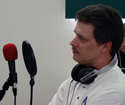
I get quite a bit of email about our weekly podcast and one of the most recent question that listeners have been asking is a technical one: “How do you get your conversations with other people to sound like they’re actually in the same room with you?†Rather than send the same explanation to each person every time I get one of these emails, I thought it would be easier to just write an article and explain how we do it.
First, a little information about the audio gear that we use.
In our main studio, Chad Perry and I use good quality XLR-type microphones. Because these microphones are not USB, and require phantom power to operate, we use the M-Audio MobilePre. http://www.smalldog.com/product/12651700/mymac The MobilePre plugs into the Macintosh via USB. Our two microphones plug into the MobilePre.
To record our end of the podcast, we use GarageBand. Because of the fact that some custom settings, which vary depending on the microphones you may use, I can’t go into settings details as it probably wouldn’t work the same from you.
Because we use a two-microphone setup, we had a problem that was easily corrected within GarageBand, but neither Chad nor I figured it out for months and months. Each of our microphones was set to a different GarageBand track, which is great. It allows us to set different settings and preferences for each input. The problem was that Chad’s microphone would record in the right channel, and mine only in the left. So when you listened back to the show, I was in your left ear, Chad was in the right. Originally, we fixed this simply by combining both microphones into one Y-plug we had custom made, so we were both in the same channel. You see the problem with this? Yup, we could only use one setting for each input, and since we were both on the same channel using this method, we couldn’t have separate settings.
The (easy) fix that still took us forever to figure out? Simply change the Input mode from Channel 1 & 2 Stereo to Channel 1 or 2 Mono for each mic. As I said, an easy fix, something we should have figured out a long while back, but never did. Sure, our method worked, but not as well.
Now Chad and I can record our end of the podcast in two separate tracks, and it sounds great. We can independently set different volume levels, EQ settings, and the like. This is good, as I tend to sit closer to my mic than Chad does, so we can either boost his input level, or decrease mine.
Guy Serle is the other cohost on the podcast. Guy lives in Virginia, while Chad and I live in Michigan. So when you listen to the podcast, you are hearing three people in two different states. Here’s how we record that end of the conversation, and how we edit it all together.
We run Skype when talking to Guy. We also use Audio Hijack Pro (AHP) ($32 from Rogue Amoeba, well worth every penny!) to record what Guy is saying. AHP allows us to select the quality of the recording, which for us is set to MP3, CBR, 192 kbps, Joint Stereo.
Once AHP is running, I tell it to “hijack” the audio coming in from Skype. There is a handy-dandy audiometer that you can look at to verify that it is indeed picking up the incoming audio from Skype. Even though it is hijacking the audio coming in from Skype, it is not actually recording that audio until you click the record button. I do that right before we actually start the podcast.
After the podcast is complete, I save the GarageBand file, switch over to the AHP and stop recording. By clicking the Recording Bin icon, I can see the MP3 that we just recorded of Guys voice. I simply drag (from the AHP window) that MP3 into a new track in GarageBand. The only real tricky part (you get better with practice) is lining up Guy’s audio in the correct place with Chad and myself. I also clip off the very end of this file within GarageBand, so that it ends at the same time as the other audio tracks.
GarageBand automatically adds new tracks with ducking turned on. I hate that. So I go back and turn ducking off, so that the AHP file of Guy talking is not lower in volume than Chad or myself. I then play parts of the show, listening to the difference in audio quality between all three tracks, adjusting and putting filters on Guy’s track so that it sounds much more like he is in the same room with us.
For those times when the three of us are interviewing a fourth person, we use the same method. The only drawback is that we use either Skype or iChat in conference mode. That means when we hijack and record that Skype audio, both Guy and the guest are on one audio track, and there is no way to independently apply adjustments to one and not the other. So if our guest has a crappy USB microphone, and Guy is using his good mic, there is little I can do to improve the guest audio quality.
(On a side note, there is no way to use both iChat and Skype at the same time. Because Guy is on Skype, and our guest is on iChat, neither of them would be able to hear each other without my running all audio through an external mixer and then back into the Macintosh. It’s possible, yes, but a HUGE pain in the you-know-what, and usually not worth the grief).
So that is how we record our podcasts, or at least part of it. Hope this helps answer any questions you may have had.

Leave a Reply
You must be logged in to post a comment.